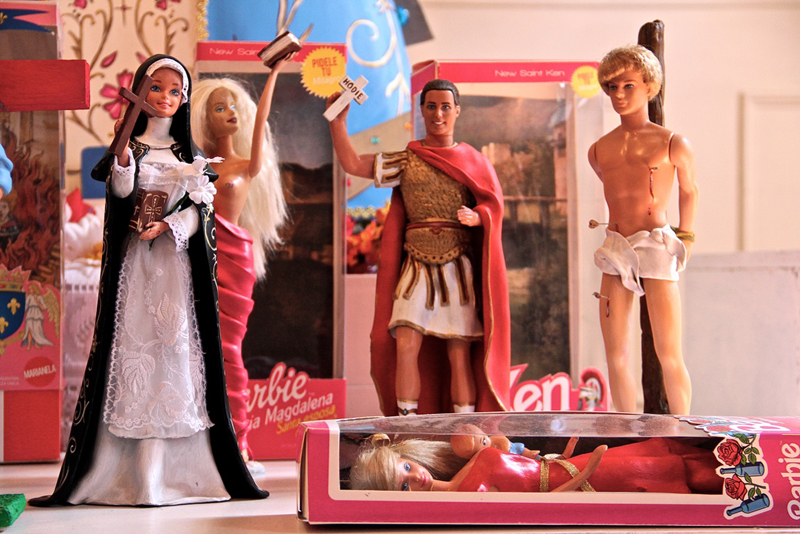
Two Argentine artists showcased on Oct. 17, 2015, a polemical artwork featuring 33 Ken and Barbie dolls as religious figures, especially from Christianity, such as Virgin Mary and Jesus Christ, in the POPA art gallery in Argentina’s capital. Photo by Kamilia Lahrichi, courtesy of USA Today
BUENOS AIRES — An artistic showcase featuring 33 Barbie and Ken dolls as religious figures — including a crucified Jesus Christ and a Virgin Mary — is sparking controversy in this Argentine capital and worldwide a year after the same event was canceled over death and other threats.
The exhibit, “Barbie, The Plastic Religion,” has infuriated religious organizations globally, especially Catholic ones in Buenos Aires, Pope Francis’ birthplace.
“Barbie and Ken have offered for decades a model of a couple that attracts children of every age to play with them and identify with them,” said Adrian Santarelli, a priest at St. Thomas More parish in Buenos Aires. “The idea of dressing (dolls) with sacred images of sacred persons alters and damages the child’s levels of understanding of the sacred.”
READ: New Vatican arts app highlights museum pieces, restoration
“Could we consider normal that a child prays to Barbie?” he added.
Artists Marianela Perelli and Emiliano Paolini said the exhibit, on display through Nov. 20 at the POPA art gallery in Buenos Aires, is purely artwork and was not meant to offend. “It was simply the union of the two most popular elements of history: the Barbie doll and religion,” Paolini said.
Among others, Barbie is depicted as Joan of Arc, Virgin of Guadalupe — Mexico’s patron saint — and Mary Magdalene, with a low-cut dress that shows her chest. Ken is shown as Buddha and Moses. The art collection also showcases Jewish and pagan mythical figures, but avoids dolls representing Muslim figures, such as the prophet Mohammed, because depiction of them is prohibited in Islam.
READ: New Islamic art exhibits planned to counter Islam’s militant image
About 400 people are expected to visit the gallery while the exhibit is on display, organizers said. Police were on hand Saturday for the unveiling of the dolls and will remain present throughout the exhibit.
The exhibit was canceled last year after a series of threats to the artwork and the artists, as well as religious and conservative groups that called the display offensive. So far this year there have not been any threats.
“For me, this exhibition is not controversial,” said Juan Villanueva, a curious art aficionado who checked out the artwork Saturday. “Using religious figures with dolls is an artistic technique which produces a nice work,” he added.
Perelli and Paolini came up with the idea after becoming captivated by sacred rituals on a trip to Mexico, where they witnessed the annual Day of the Dead celebrations. They argue that if there is a Barbie nurse, astronaut and rock star, why wouldn’t there be a religious one?
READ: 12 “blasphemous” artworks censored or vandalized by angry believers
“I think that our work was misinterpreted, and (people opted for) a defensive position on an artwork that was not believed to be offensive, but it seemed that it was hiding something terrible, suspicious,” Perelli said.
“I think that Barbie has a bad reputation but the reality is that she’s the most widely sold doll to children so why do people think she’s like a prostitute?” Perelli added.
Still, the unorthodox artwork has angered other religious denominations as well, including Hindus for its depiction of the goddess Kali. Rajan Zed, a Hindu cleric living in Nevada called the “Barbie-fication of Kali … simply improper, wrong and out of place.”
Not everyone agrees with that view.
“We can’t be stuck in the past with our traditions,” said Elina Aguilar, a retired woman attending the display’s opening. “It doesn’t outrage me.”
Hugo Fryszberg, 55, an employee of the Buenos Aires government, pointed out dolls have been sold of other religious figures without issue.
“It shouldn’t offend Catholics … as there were dolls of Pope Francis that were sold in the U.S. during his visit with a clear commercial end,” he said.
LM END LAHRICHI




